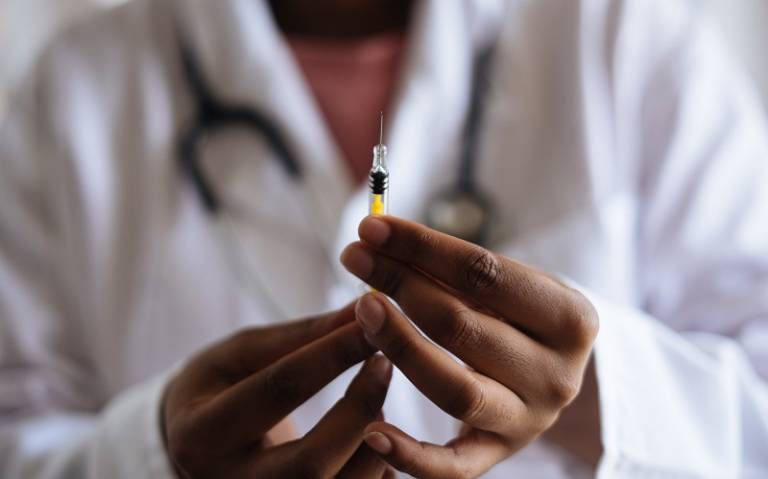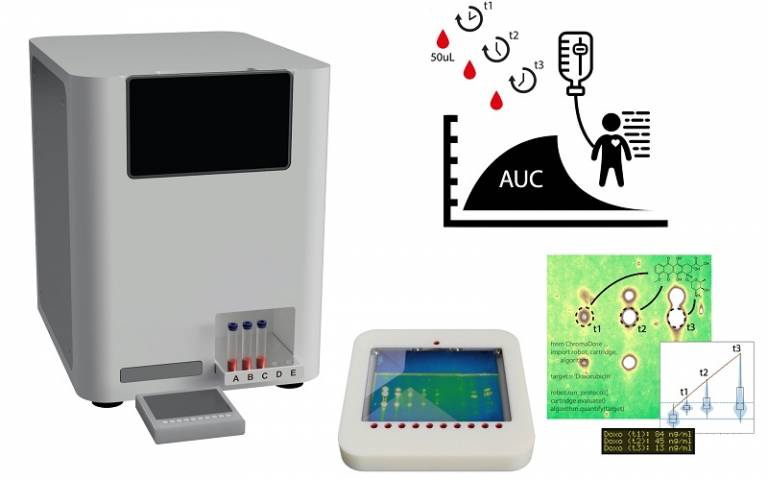Drug dosing technology to improve children’s cancer treatment
15 March 2021
A project led by UCL – ChromaDose – will aid more precise drug dosing in children with cancer.

Children receiving chemotherapy treatment each process the drugs differently, leading to inconsistencies in drug concentrations in the blood (known as drug exposure). Patients may not receive enough of the drug or in some cases may experience side effects following anthracycline treatment, predominantly in the form of dose-related cardiotoxicity.
The multidisciplinary team of experts working on ChromaDose will develop a diagnostic drug monitoring tool to aid dose optimisation, enabling children receiving anthracycline chemotherapy – a type of the drug most commonly used to treat childhood lymphomas and leukaemias – to benefit from a personalised approach to treatment.
The technology behind ChromaDose will enable clinicians to calculate the patient’s drug exposure. Nurses administering the chemotherapy drug would collect a few drops of blood at different times following administration. These samples are then inserted into the ChromaDose bedside device using an innovative cassette design.

The machine automatically measures the amount of medicine within each blood drop and identifies the patient’s pharmacokinetic response, meaning the movement of drugs into and around the body, allowing ChromaDose to calculate the patient’s drug exposure.
Co-lead Professor Pamela Kearns (University of Birmingham, President of the European Society of Paediatric Oncology) explained: “In 2021, there are nearly half a million survivors of childhood cancer in Europe and two thirds live with long term side effects from their treatment.”
“One way to improve the side effect profile of a drug is to be more precise in the dosing. ChromaDose has the potential to allow us to individualise the dose of chemotherapy drugs to maximise effect on the tumour while minimising the side effects.
“I am looking forward to working with the team to move ChromaDose into clinical practice as a substantial step towards personalised medicine for children with cancer.”
Overall project lead Dr Stefan Guldin (UCL Chemical Engineering), further explained: “We have come a long way from the first experiments in the lab to this unique opportunity to bring our technology into the clinic. The team we have been able to assemble in ChromaDose makes me confident that we can achieve our ambitious goals.”
Academics currently have the individual components which have shown promise when operated manually in a laboratory. They will now work to integrate these elements into an automated companion monitoring tool that will be able to provide reliable results within 30 minutes from insertion of the sample.
“The challenge of developing a fully-automated in-vitro diagnostic device for biochemical analysis on the ward cannot be underestimated,” explained team member Dr Alaric Taylor (Innovation & Design Lead, Vesynta Ltd – a UCL startup). “Safety, performance, user experience and regulatory compliance are all competing factors.
“However, I believe that working within the ChromaDose consortium, with input and support from each and every stakeholder, makes the delivery of this technology possible.”
Co-lead Professor Gareth Veal (University of Newcastle) commented: “We have made great strides over a number of years in providing a national therapeutic drug monitoring service to support dosing decisions being made for childhood cancer patients across the UK.
“The development of a point-of-care diagnostic device funded through the i4i project could have a real impact on utilising drug monitoring approaches as routine cancer patient care in the future.”
The research team are working with a diverse group of stakeholders including children, parents, nurses, doctors, educators, designers, scientists and engineers. The Young Persons Advisory Groups (YPAGs) at Great Ormond Street Hospital and North England were actively involved in the project planning stage with over 60 participants and remain important collaborators throughout the project. Additionally, parents and wider families of children who have experienced cancer will contribute through the Paediatric Oncology Reference Team (PORT).
Stakeholder satisfaction and user scenarios analysis will aid the translation of the ChromaDose innovation into the NHS healthcare system. This work is supported by partners at the NIHR funded, London In-Vitro Diagnostic Co-operative at Imperial College London. The expert team will map pathways for clinical integration alongside early stage health economic analysis, ensuring patient benefit is delivered rapidly and cost-effectively.
The ChromaDose project is funded by an NIHR i4i Product Development Award, which provides £980,000 for a nationwide multi-disciplinary team to conduct intensive research and development over 30 months. As project capstone, the team will seek regulatory approval from the notified body for widespread adoption.
Video
Links
Image
Further quotes:
Deirdre Leyden (Patient and Public Involvement (PPI) Rep – Children, NIHR Great Ormond Street Biomedical Research Centre): “We are excited to continue working with the team around PPIE for this project and look forward to ensuring the voices of children and young people are heard as the project develops.”
Jugal Suthar (Project Manager and Commercial Engagement, UCL): “After 18 months of careful planning and research, we feel privileged to have brought together a holistic team of multidisciplinary industry leaders to address the challenge of medicine safety in childhood cancer. This proposal represents a pioneering yet considered approach and I am looking forward to helping to translate our innovation into a critical healthcare setting.”
Media contact
Kate Corry
Tel: +44 (0)20 3108 6995
Email: k.corry [at] ucl.ac.uk
 Close
Close

